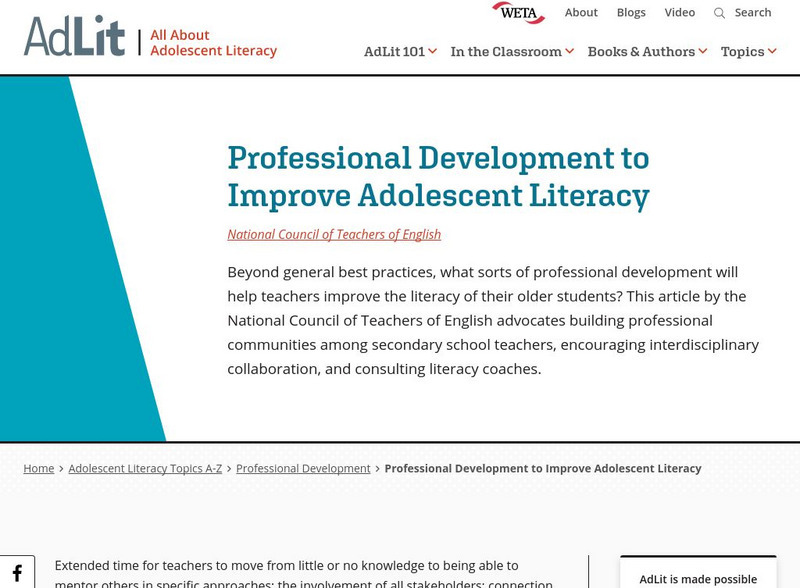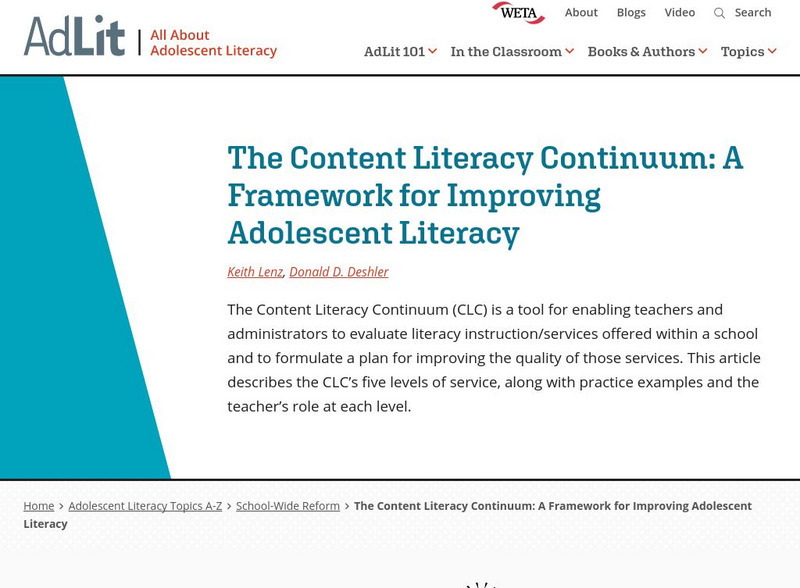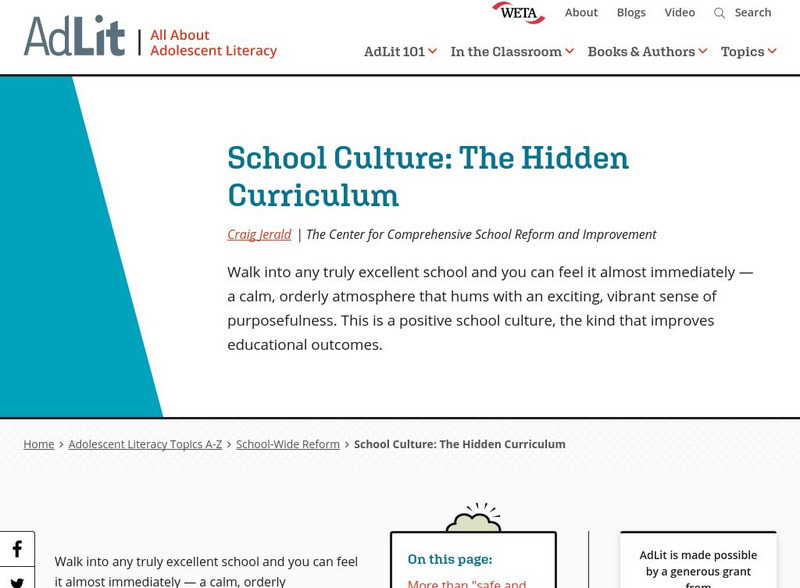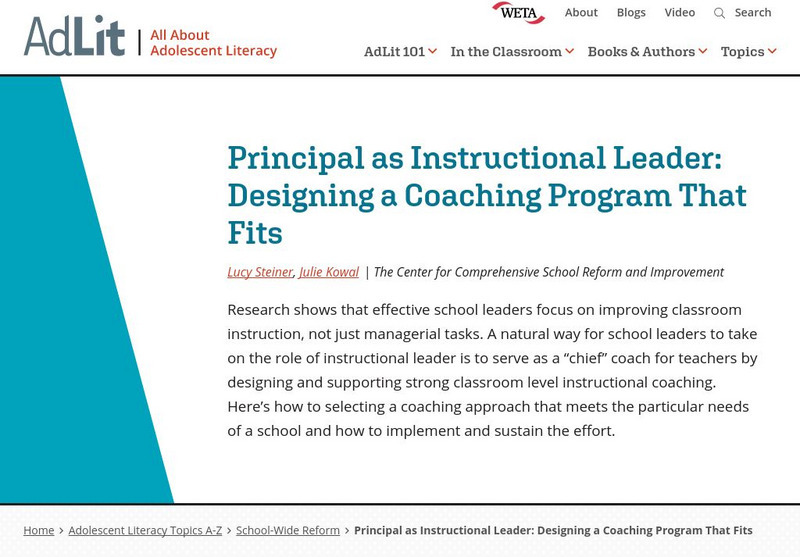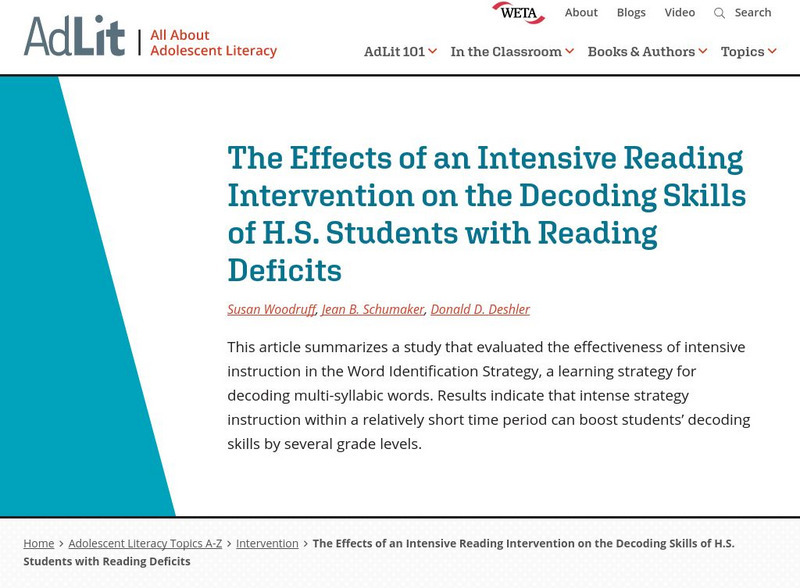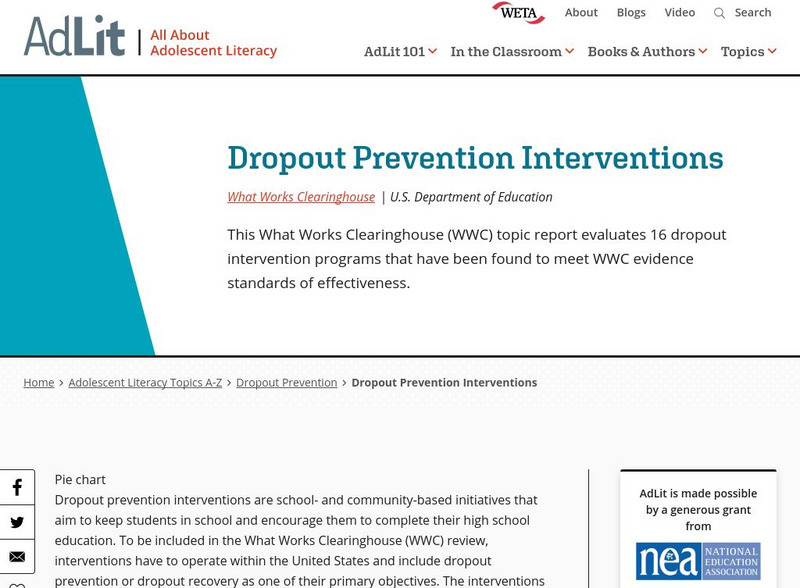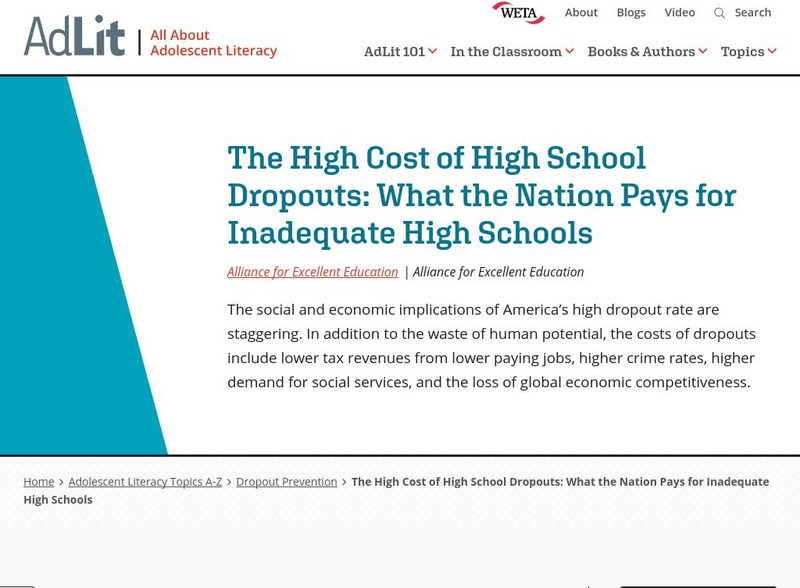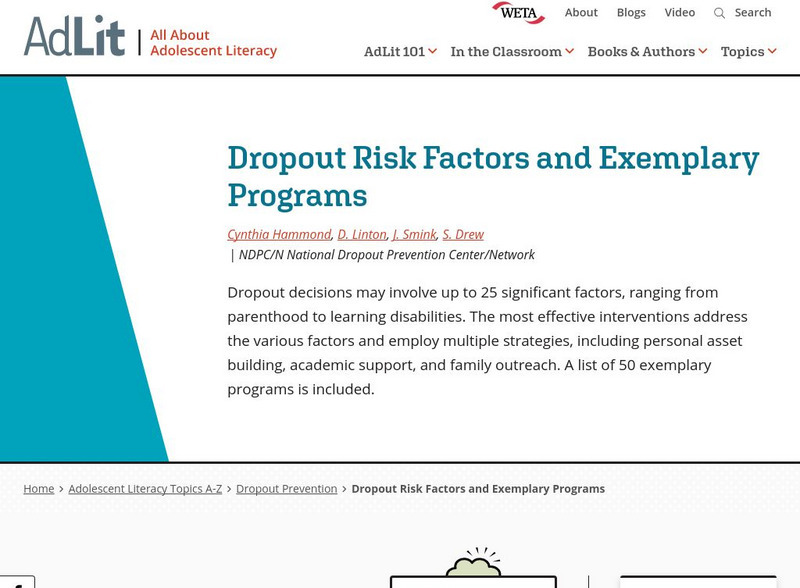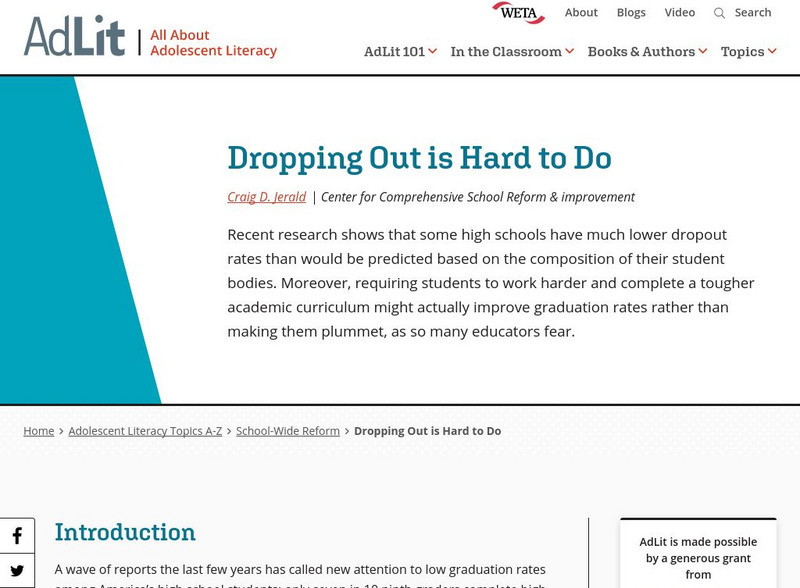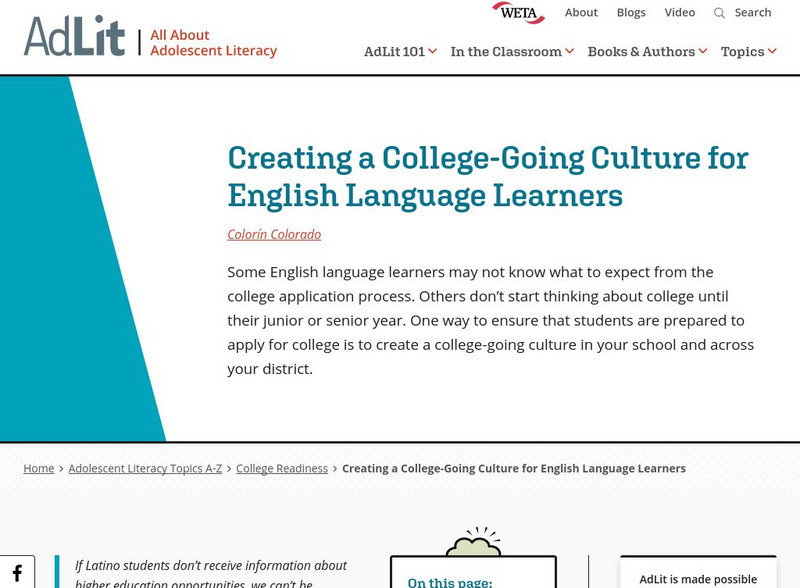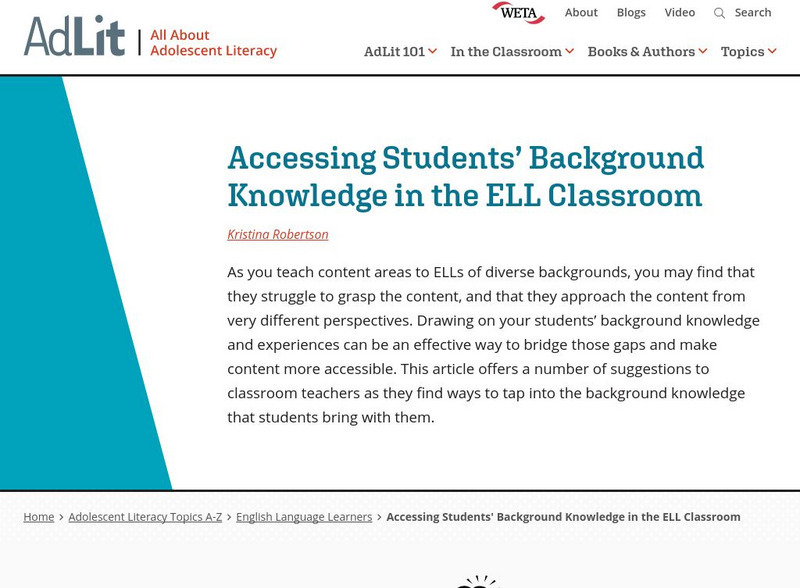AdLit
Ad lit.org: Professional Development to Improve Adolescent Literacy
Beyond general best practices, what sorts of professional development will help teachers improve the literacy of their older students? This article by the National Council of Teachers of English advocates building professional...
AdLit
Ad lit.org: Reading and Writing in the Academic Content Areas
This issue brief from the Alliance for Excellent Education looks at the role every middle and high school teacher must play to help older students become fully literate, and puts forth a four-part agenda for improving literacy in the...
AdLit
Ad lit.org: The Content Literacy Continuum: Improving Adolescent Literacy
The Content Literacy Continuum (CLC) is a tool for enabling teachers and administrators to evaluate literacy instruction/services offered within a school and to formulate a plan for improving the quality of those services. This article...
AdLit
Ad lit.org: Adolescents and Literacy: Reading for the 21st Century
This report reviews and analyzes existing research on effective literacy instruction and the impact of successful literacy programs for students in grades 4-12.
AdLit
Ad lit.org: Teach to the Test? Just Say No
It is possible for educators to make better choices about how and when to teach to the test than the alarmist newspaper articles and editorials would seem to suggest. This article from the Center for Comprehensive School Reform and...
AdLit
Ad lit.org: School Culture: The Hidden Curriculum
Walk into any truly excellent school and you can feel it almost immediately - a calm, orderly atmosphere that hums with an exciting, vibrant sense of purposefulness. This is a positive school culture, the kind that improves educational...
AdLit
Ad lit.org: Rti and Reading: Response to Intervention in a Nutshell
RTI is not a particular method or instructional approach, rather it is a process that aims to shift educational resources toward the delivery and evaluation of instruction that works best for students. This article provides a quick...
AdLit
Ad lit.org: Principal as Instructional Leader: Designing a Coaching Program
Research shows that effective school leaders focus on improving classroom instruction, not just managerial tasks. A natural way for school leaders to take on the role of instructional leader is to serve as a "chief" coach for teachers by...
AdLit
Ad lit.org: Ten Myths About Learning to Read
There are many beliefs and a great deal of dogma associated with reading acquisition, and people are often reluctant to let go of their beliefs despite contradictory research evidence. Here are 10 of the most popular and most potentially...
AdLit
Ad lit.org: So if Retention Is So Harmful, What Should We Do? Teach!
Studies on grade retention reach the same conclusion: Failing a student, particularly in the critical ninth grade year, is the single largest predictor of whether he or she drops out. What must teachers know to identify students' needs...
AdLit
Ad lit.org: Effects of Intensive Reading Intervention of Decoding Skills
This article summarizes a study that evaluated the effectiveness of intensive instruction in the Word Identification Strategy, a learning strategy for decoding multi-syllabic words. Results indicate that intense strategy instruction...
AdLit
Ad lit.org: Dropout Prevention Interventions
This What Works Clearinghouse (WWC) topic report evaluates 16 dropout intervention programs that have been found to meet WWC evidence standards of effectiveness.
AdLit
Ad lit.org: The High Cost of High School Dropouts: What the Nation Pays
The social and economic implications of America's high dropout rate are staggering. In addition to the waste of human potential, the costs of dropouts include lower tax revenues from lower paying jobs, higher crime rates, higher demand...
AdLit
Ad lit.org: What Are the Key Components of Dropout Prevention Programs?
Dropout prevention research shows that most programs use more than one type of intervention (family outreach, academic tutoring, personalization and vocational training, for example). While there is no one right way to intervene,...
AdLit
Ad lit.org: What Do We Know About Who Drops Out and Why?
Students decide to drop out for many reasons. This overview classifies the reasons as either status (e.g., age, socioeconomic status, geographic region or mobility) or alterable (e.g., grades, disruptive behaviors, school climate,...
AdLit
Ad lit.org: Dropout Risk Factors and Exemplary Programs
Dropout decisions may involve up to 25 significant factors, ranging from parenthood to learning disabilities. The most effective interventions address the various factors and employ multiple strategies, including personal asset building,...
AdLit
Ad lit.org: Dropping Out Is Hard to Do
Recent research shows that some high schools have much lower dropout rates than would be predicted based on the composition of their student bodies. Moreover, requiring students to work harder and complete a tougher academic curriculum...
AdLit
Ad lit.org: Creating a Welcoming Classroom Environment
On a daily basis, ELLs are adjusting to new ways of saying and doing things. As their teacher, you are an important bridge to this unknown culture and school system. There are a number of things you can do to help make ELLs' transitions...
AdLit
Ad lit.org: Creating a College Going Culture for English Language Learners
Some English language learners may not know what to expect from the college application process. Others don't start thinking about college until their junior or senior year. One way to ensure that students are prepared to apply for...
AdLit
Ad lit.org: Successful Parent Teacher Conferences With Bilingual Families
How can you hold an effective parent-teacher conference with the parents of English language learners if they can't communicate comfortably in English? This article provides a number of tips to help you bridge the language gap, take...
AdLit
Ad lit.org: Accessing Students' Background Knowledge in the Ell Classroom
As you teach content areas to ELLs of diverse backgrounds, you may find that they struggle to grasp the content, and that they approach the content from very different perspectives. Drawing on your students' background knowledge and...
AdLit
Ad lit.org: What Does Research Tell Us About Teaching Reading to El Ls?
In this article, a seasoned ELL teacher synthesizes her own classroom experience and the findings of the National Literacy Panel on Language-Minority Children and Youth to make recommendations for effective literacy instruction of ELL...
AdLit
Ad lit.org: Communication Strategies for All Classrooms: Focusing on Ell
Concrete suggestions for teachers who want to communicate well with all of their students, especially English language learners and students with learning disabilities.
AdLit
Ad lit.org: Reading Comprehension Strategies for English Language Learners
Explicit teaching of reading comprehension skills will help English Language Learners apply these strategies to all subject matter.


